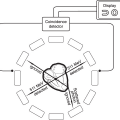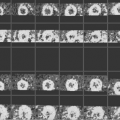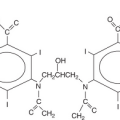Equilibrium Radionuclide Angiography
Kusai S. Aziz
Current Uses and Protocols
The other name for equilibrium radionuclide angiography (ERNA) is MUGA (multi-gated acquisition) scans. It is used mainly for evaluation of left ventricular systolic function at rest. However, ERNA can also be used for other indications such as evaluation of right ventricular systolic function or for the diagnosis of coronary artery disease when it is combined with exercise by looking for post exercise drop of left ventricular ejection fraction (LVEF). The use of this technique has declined during the last several years because of the widespread use of less time-consuming tests to evaluate systolic function, such as echocardiogram, and because of the introduction of gating in single photon emission computed tomography (SPECT) myocardial perfusion imaging, which calculates left ventricular ejection fraction and gives an idea about wall motion. However, it should kept in mind that MUGA scans are the most accurate and reproducible technique for EF calculation since they depend on the count numbers during systole and diastole, and unlike echocardiogram or gated SPECT do not have geometric assumptions that can lead to false LVEF calculations. Therefore, these scans still used when accurate evaluation of LVEF is needed, and as a tie-breaker when there are conflicting measurements of LVEF.
Stay updated, free articles. Join our Telegram channel

Full access? Get Clinical Tree






